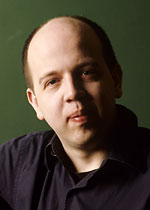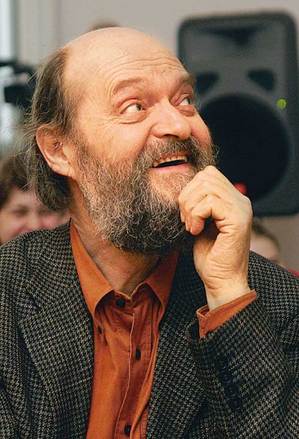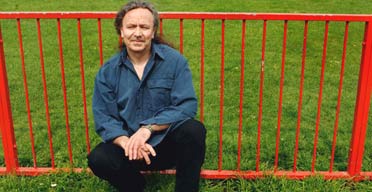On Four Saturdays in August and September, the BBC Proms has been presenting Saturday matinee concerts in Cadogan Hall in Sloane Square. On August 20, The London Sinfonietta, the BBC Singers, soloists Andrew Watts, Jeffrey Lloyd-Roberts, and Nicolas Hodges, conducted by David Atherton, performed works of Peter Maxwell Davies and Harrison Birtwistle, along with the first performance of a work commissioned by the BBC from Georges Aperghis. Davies’s Il rozzo martello (The Crude Hammer), written for the BBC Singers in 1997sets a sonnet by Michaelangelo, preceded by a stanza from Dante’s Paradiso (II-127-132) and followed by an prose annotation of it by its author. All three of the texts focus on the image of the hammer of the smith and of the sculptor as a metaphor for artistic creation and further for the divine shaping of the universe. (Whether it was intentional that the title is more or less the same as that of Le Marteau San Maître, whose text also deals with artistic creation, is an open question). After an introduction in which each of the voice sections enters in turn with long phrases accumulating into chords, Davies sets both of the first two quatrains of the sonnet in turn with homophonic music which is then repeated with a elaborate and floridly melismatic descant sung by soloists. The sestet returns to the initial homophonic texture enriched with more voices. The concluding annotation is given an almost patter setting, with a concluding broad phrase repeating the opening line of the Dante. In certain respects the work represents a fusion of the style and tonal language of Davies’s more recent, Naxos quartet, music with that of some of his earliest choral music written for students at the Cirencester Grammar School.
Georges Aperghis, a Greek composer who now lives in France, is known for his involvement in experimental theater, being the founder of the theater company ATEM (Atelier Théâtre et Musique) in Paris. The title of Aperghis’s concerto for piano and chamber orchestra, Champ-Contrechamp, means Shot-Reverse Shot, which is a technical term from film editing dealing with editing film of two people, shot at different times and in different places, so that they appear to be having a conversation. The piece is a handsome sounding whirling and shimmering dialog of great surface activity between the piano and the orchestra which builds to a climax and then rather quickly unwinds to a sparse slow coda for the soloist.
Birtwistle’s Angel Fighter, written for the 2010 Leipzig Bachfest, sets a text by Stephen Plaice which dramatizes the story of Jacob wrestling with an angel. The work begins with accusations of Jacob by his conscience (represented by the chorus) as he is dividing his livestock and tribe in anticipation of a confrontation with his brother Essau, whose birthright he stole. In answer to Jacob’s call for a sign from Yahweh, an angel appears, singing in Enochian, the universal language of men, lost in the Great Flood. The angel descends and speaks to Jacob in his own language. In order to prove to the doubting Jacob that he is real, the angel insists that they fight, and Jacob, against all odds, prevails against him. As the night is ending the angel threatens to kill Jacob if he does not let him go, which Jacob refuses to do unless the angel blesses him. Having received the angel’s blessing, Jacob, now Israel, asks his name, which the Angel refuses to give. As the angel disappears, the work ends with blessings in Hebrew.
Angel Fighter is constantly at a very high level of dramatic intensity, which is relaxed only briefly close to the end when the angel sings an aria about his refusal to give his name. This is accompanied only by harp and English horn, and it is also the only instance of any lessening of the work’s textural density, which is otherwise remarkably full and intricately detailed and constant. Despite its density the instrumental writing is calculated so that it does not in any way obscure the vocal writing, which is highly florid and effective, and in turn set so that its delivery of all the words is always completely clear (well the English–I can’t speak to the setting of the Enochian).
A week earlier, the Sinfonietta, conducted by Nicholas Collon, presented a program featuring music by Richard Rodney Bennett, whose 75th birthday the Proms is commemorating. The concert opened with Dream Dancing, which is scored for the collective instrumentation of the late Debussy Sonatas. Debussy projected six sonatas, but had only finished three of them before he died. The three finished have relatively straightforward instrumentation (‘cello and piano; violin and piano,; flute, viola, and harp); the fourth was intended to be for oboe, horn, and harpsichord, and the fifth for clarinet, trumpet, bassoon, and piano. I had never heard of an instrumentation for the sixth before, but the commentary at this concert seemed to say that the sixth was supposed to be for the entire complement, as this piece is. Dream Dancing is in two movements, lasting about 16 minutes. The music is fluent and elegant and expressive in a sort of general way, as film music would need to be.
Henri Dutilleux was represented by his Les citations, a short piece for oboe with harpsichord, double bass, and percussion. It is also in two movements, the first features a long oboe solo line with its spaces at first filled in and amplified by unpitched percussion, but is gradually joined by the other instruments, which offer a quietly accelerating background In the second movement, which is based on material from a piece by Jean Alain, and from music from Janequin which Alain quoted in a work of his, the activity is more equally distributed among the players. The performance of this work was extremely polished; the playing of oboist Gareth Hulse and double bassist Enno Senft was particularly beautiful. The Romanza by Elizabeth Maconchy for viola and chamber orchestra feature Paul Silverthorne. It is a clearly and convincingly shaped work whose texture is a little murky and clumsy.
The concert concluded with Bennett’s Jazz Calendar which was commissioned by the BBC in 1963 as a concert piece, but which became best known through a ballet which Kenneth MacMillan made to it. Bennett characterized Jazz Calendar, whose seven movements depict the characteristics claimed by the famous nursery rhyme for children born on the different days of the week (“Monday’s child is fair of face, Tuesday’s child is full of grace, etc.), as being completely a jazz piece, rather than some kind of third stream classical piece. It’s scoring is for a small jazz band, and it is something of a tribute to Gil Evans. The piece is a complete charmer and it got a fabulous performance.
All these concerts can be heard on the Proms website (http://www.bbc.co.uk/proms) for a week after the performance.


